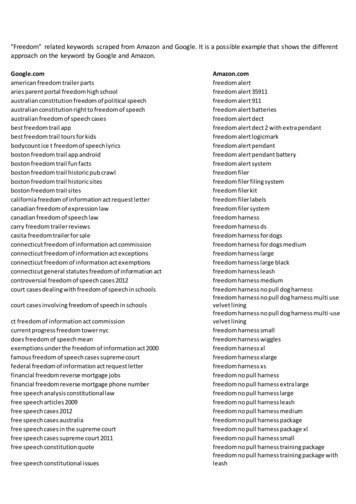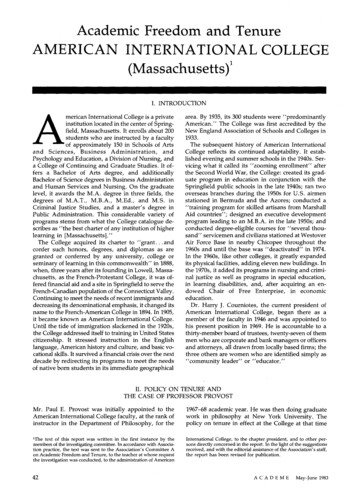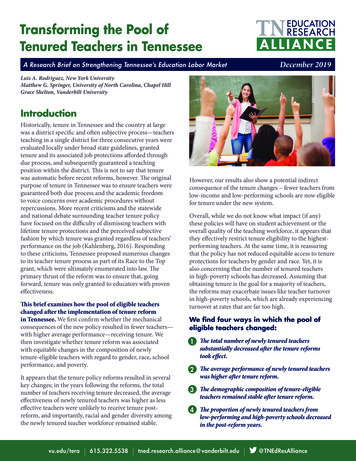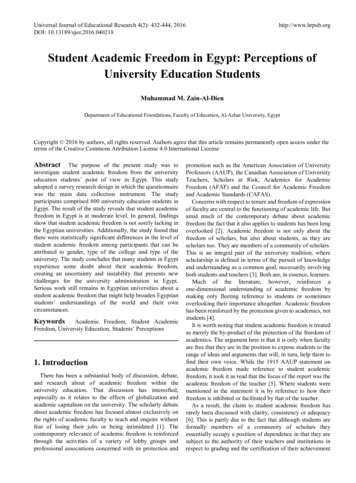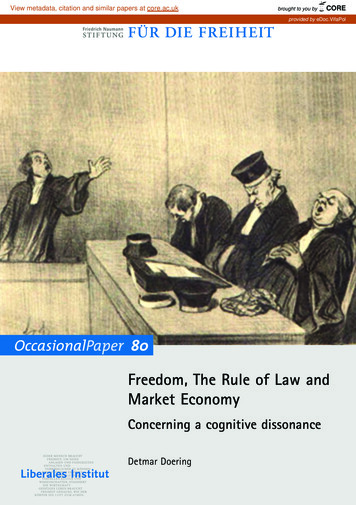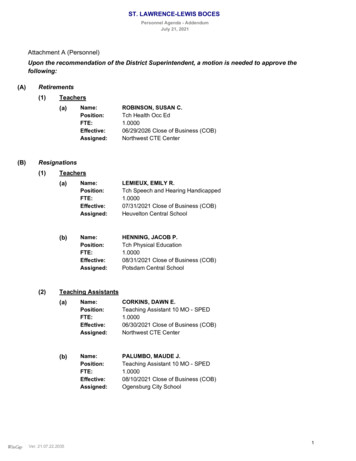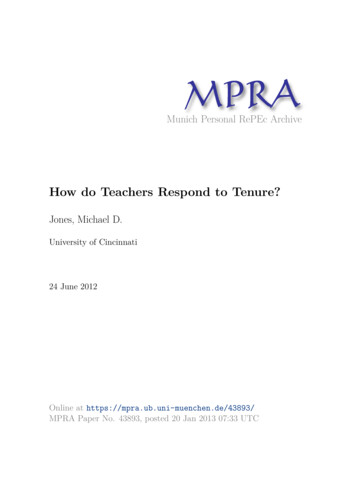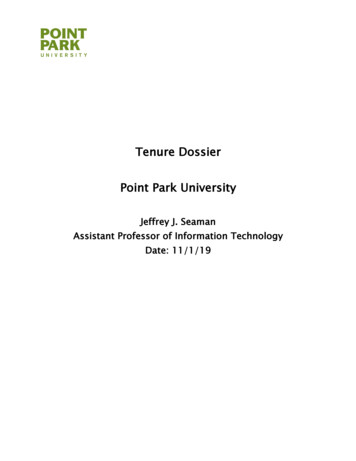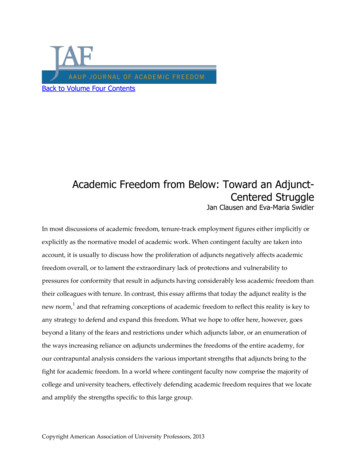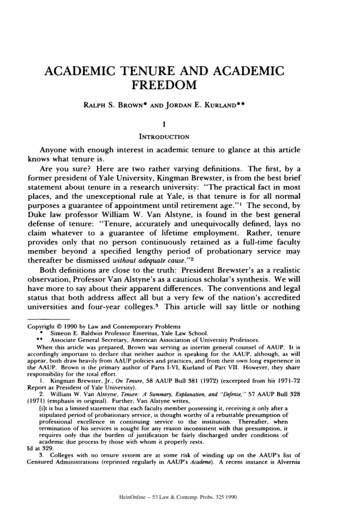
Transcription
ACADEMIC TENURE AND ACADEMICFREEDOMRALPH S. BROWN* AND JORDANE.KURLAND**IINTRODUCTIONAnyone with enough interest in academic tenure to glance at this articleknows what tenure is.Are you sure? Here are two rather varying definitions. The first, by aformer president of Yale University, Kingman Brewster, is from the best briefstatement about tenure in a research university: "The practical fact in mostplaces, and the unexceptional rule at Yale, is that tenure is for all normalpurposes a guarantee of appointment until retirement age.", The second, byDuke law professor William W. Van Alstyne, is found in the best generaldefense of tenure: "Tenure, accurately and unequivocally defined, lays noclaim whatever to a guarantee of lifetime employment. Rather, tenureprovides only that no person continuously retained as a full-time facultymember beyond a specified lengthy period of probationary service may2thereafter be dismissed without adequate cause."Both definitions are close to the truth: President Brewster's as a realisticobservation, Professor Van Alstyne's as a cautious scholar's synthesis. We willhave more to say about their apparent differences. The conventions and legalstatus that both address affect all but a very few of the nation's accrediteduniversities and four-year colleges. 3 This article will say little or nothingCopyright 1990 by Law and Contemporary Problems*Simeon E. Baldwin Professor Emeritus, Yale Law School.** Associate General Secretary, American Association of University Professors.When this article was prepared, Brown was serving as interim general counsel of AAUP. It isaccordingly important to declare that neither author is speaking for the AAUP, although, as willappear, both draw heavily from AAUP policies and practices, and from their own long experience inthe AAUP. Brown is the primary author of Parts I-VI, Kurland of Part VII. However, they shareresponsibility for the total effort.1. Kingman Brewster, Jr., On Tenure, 58 AAUP Bull 381 (1972) (excerpted from his 1971-72Report as President of Yale University).2. William W. Van Alstyne, Tenure: A Summary, Explanation, and "Defense, " 57 AAUP Bull 328(1971) (emphasis in original). Further, Van Alstyne writes,[i]tis but a limited statement that each faculty member possessing it, receiving it only after astipulated period of probationary service, is thought worthy of a rebuttable presumption ofprofessional excellence in continuing service to the institution. Thereafter, whentermination of his services is sought for any reason inconsistent with that presumption, itrequires only that the burden of justification be fairly discharged under conditions ofacademic due process by those with whom it properly rests.Id at 329.3. Colleges with no tenure system are at some risk of winding up on the AAUP's list ofCensured Administrations (reprinted regularly in AAUP's Academe). A recent instance is AlverniaHeinOnline -- 53 Law & Contemp. Probs. 325 1990
326LAW AND CONTEMPORARYPROBLEMS[Vol. 53: No. 3about two-year community colleges. While two-year institutions account foralmost 40 percent of post-secondary enrollments, 4 their practices range froma tenure system following the higher education model, to the public schoolmodel of granting tenure routinely after the teacher has served for two or5three years without running into difficulties, to no tenure system at all.The conventions and entitlements of tenure have existed for generations.Walter Metzger, in a comprehensive historical essay on academic tenure,describes the judicial mode of controlling dismissals demonstrated byuniversity tribunals affording due process. 6 Metzger ascribes the recognitionof the judicial mode to the famous 1915 "philosophical birth cry' '7 of theAmerican Association of University Professors ("AAUP"), the Declaration ofPrinciples of its Committee on Academic Freedom and Academic Tenure.That Declaration, in its "Practical Proposals," declared firmly that[i]n every institution there should be an unequivocal understanding as to the term ofeach appointment; and the tenure of professorships and associate professorships, andof all positions above the grade of instructor after ten years of service, should bepermanent (subject to the provisions hereinafter given for removal upon charges). 8The next major milestone in the development of tenure was the 1940Statement of Principles on Academic Freedom and Tenure. 9 While the 1915Declaration was the work of a committee of professors, the 1940 Statementwas a joint production of professors and university and college presidents.1 0Endorsed by the Association of American Colleges ("AAC") (and over theensuing fifty years by more than 140 professional organizations),' I the 1940Statement proclaimed that[t]enure is a means to certain ends; specifically: (1) Freedom of teaching and researchand of extramural activities and (2) a sufficient degree of economic security to makethe profession attractive to men and women of ability. Freedom and economicsecurity, hence, tenure, are indispensable tothe success of an institution in fulfilling its12obligations to its students and to society.College (Pennsylvania), the subject of a report in 76 Academe 67 (January-February 1990), andcensured in June 1990.4. U.S. Bureau of the Census, Statistical Abstract of the U.S. 153 (110th ed 1990).5. In 1987, 62% of public two-year colleges had a tenure system, compared to 99% of fouryear public institutions, according to a 1988 U.S. Department of Education survey reported inCarolyn J. Mooney, New U.S. Survey Assembles a Statistical Portrait of the American Professoriate, ChronHigher Educ A15, A19 (February 7, 1990).6.Walter P. Metzger, Academic Tenure in America: A HistoricalEssay, in Commission on AcademicTenure in Higher Education, Faculty Tenure 93 (Jossey-Bass, 1973) ("Academic Tenure"). Thepioneering work on tenure practices and law is Clark Byse & Louis Joughin, Tenure in American HigherEducation: Plans, Practices, and the Law (Cornell Univ Press, 1959).7.Metzger, Academic Tenure at 148 (cited in note 6).General Report of the Committee on Academic Freedom and Academic Tenure, 1 AAUP Bull 17, 40- 41(1915) (" 1915 Declaration"); see Appendix A, 53 L & Contemp Probs 393, 405-06 (Summer 1990).8.9. 1940 Statement of Principles on Academic Freedom and Tenure ("1940 Statement"), in PolicyDocuments and Reports 3 (AAUP, 1984) ("1984 AAUP Red Book"); see Appendix B, 53 L & ContempProbs 407 (Summer 1990).10.See Walter P. Metzger, The 1940 Statement of Principles on Academic Freedom and Tenure, 53 L &Contemp Probs 3 (Summer 1990).11. There was an intermediate "Conference Report" of 1925, not germane to this survey. Forthe most recent list of endorsers of the 1940 Statement, see AAUP, Policy Documents and Reports 3(AAUP, 1990) ("1990 AAUP Redbook").12.1940 Statement at 3; Appendix B at 407 (cited in note 9).HeinOnline -- 53 Law & Contemp. Probs. 326 1990
Page 325: Summer 1990]ACADEMIC TENURE AND ACADEMICFREEDOMHere one finds a second emphasis-on economic security-and, further on inthe Statement, a refinement of procedural protections, along with ashortening of the allowable probationary period to seven years.The 1940 Statement marks the maturity of the linkage of academic tenureto academic freedom. The Statement-incorporated, often verbatim, in thepolicies of hundreds of colleges and universities-is the yardstick for3measuring adherence to proper standards of academic freedom and tenure.1Although many would limit academic freedom, some very seriously, hardlyanyone nowadays attacks it head on. But academic tenure is always underattack. Usually we hear only grumbling and rumbling, as of distant artillery.But occasionally there is a prolonged fire-fight. The last such episode flaredup in the early 19 7 0s, when the long postwar expansion of higher educationslowed. Jobs became scarce. Many institutions that had been lavish inconferring tenure proclaimed themselves "overtenured."' 4 Much of thedisputation upon which this paper relies comes from that decade.' 5 Now, in1990, the pendulum may have swung. Those hired to teach the baby-boomersare approaching retirement. We are told that there will be more jobs.16 Yetdissatisfaction still surfaces. 17 It is noteworthy that proponents of tenure areperennially on the defensive; recall the title of Van Alstyne's article, Tenure: ASummary, Explanation, and "Defense. "18 The attacks tend to be hit-and-run;' 920the defensive statements are more sustained.13. "Probably because it was formulated by both administrators and professors, all of thesecondary authorities seem to agree that it is the 'most widely-accepted academic definition oftenure'." Krotkoffv Goucher College, 585 F2d 675, 679 (4th Cir 1978) (citations omitted). See generallyNote, The Role of Academic Freedom in Defining the Faculty Employment Contract, 31 Case W Res L Rev 608(1981) (authored by Richard H. Miller); Ralph S. Brown & Matthew W. Finkin, The Usefulness of AA UPPolicy Statements, 59 Educ Record 30 (1978).14. See Fred M. Hechinger, Job Crunch Spurs Debate on Tenure, New York Times § 3 at 5 col 4(January 16, 1979). After noting the "huge expansion" of the 1950s and 1960s, and the attendant"crippling shortage of teachers," Hechinger writes that "[flaculty members were hired . with adiminishing concern for their true, lasting capacities. Often, they were given tenure after less thancomplete scrutiny. Such profligate uses of tenure did much to bring it into disrepute." Id.15. See also Malcolm G. Scully, Attacks on Tenure Mount; Limitations are Proposed in 5 States, ChronHigher Educ 1 (March 22, 1971) ("Attacks on Tenure Mount").16. See William G. Bowen & Julie Ann Sosa, Prospectsfor Faculty in the Arts and Sciences: A Study ofFactorsAffecting Demand and Supply, 1987-2012 134-35, 142-43 (Princeton Univ Press, 1989). CarolynJ. Mooney, Uncertainty is Rampant as Colleges Begin to Bracefor Faculty Shortages Expected to Begin in 1990s,Chron Higher Educ A14 (January 25, 1989).17. See, for example, Page Smith, Killing the Spirit: Higher Education in America 114-22 (VikingPress, 1990) ("Killing the Spirit").18. See note 2.19. A recent instance is a short editorial piece, The Tenure Temptation: Don't Give Professors LifetimeJobs, 302 The Economist 15 (February 28, 1987).20. In the last 20 years, there has been an impressive array of statements that, on balance,support academic tenure. A varied collection of essays-some critical-is Bardwell L. Smith &Associates, eds, The Tenure Debate (Jossey-Bass, 1973). In the same year appeared Faculty Tenure (citedin note 6), the report of an independent Commission on Academic Tenure in Higher Educationsponsored by the AAC and the AAUP, and funded by the Ford Foundation. Two universitycommittees produced substantial reports that, even though they reflect the acute tensions of theirtimes, have continuing interest: University of Utah Commission to Study Tenure, 57 AAUP Bull 421(1971); Academic Tenure at Harvard University, 58 AAUP Bull 62 (1972). See also Fritz Machlup, InDefense of Academic Tenure, 50 AAUP Bull 112, 118 (1964). A recent temperate appraisal is HenryHeinOnline -- 53 Law & Contemp. Probs. 327 1990
LAW AND CONTEMPORARY PROBLEMS[Vol. 53: No. 3Although this paper will accentuate the affirmative, it too will unavoidablytake a counter-attacking posture. Part II will address briefly the heart of thematter: does academic tenure reinforce academic freedom? Of course itdoes. We will then consider in Part III the asserted costs of tenure and thereasons behind the chronic criticism. Part IV, accepting the significanteconomic and social costs of tenure, will describe other substantial advantagesof the practice, beyond the direct safeguarding of academic freedom. We willthen ask in Part V whether alternative devices would effectively protectacademic freedom--devices such as legal defenses, internal safeguards, lessthan-career tenure, or tenure reviews-and conclude that they would not.Part VI examines leaks in the dike of conventional tenure: due processdeficiencies; the extent to which tenure may be undermined by financialexigency claims or by discontinuing entire programs; and the uneaseoccasioned by the coming demise of mandatory retirement. Part VII turns tothe plight of the untenured. What protects their academic freedom?IIACADEMIC TENURE AS THE PRIMARY DEFENSE OF ACADEMICFREEDOMThe conferral of tenure makes it very difficult thereafter to dismiss aprofessor for views expressed in the classroom, in scholarly writing, or inpublic arenas. 2 1 As Van Alstyne's definition emphasizes, the university hasthe burden of demonstrating that the faculty member has said or done thingsoffensive enough to warrant dismissal. But there is more involved thanburden of proof. What constitutes adequate cause for dismissal? Someuniversity regulations provide laundry lists of potential offenses, but more aresilent on the matter. A fairly standard formulation would resemble therecommendation of the 1973 Commission on Academic Tenure, that"'adequate cause' in faculty dismissal proceedings should be restricted to (a)demonstrated incompetence or dishonesty in teaching or research, (b)substantial and manifest neglect of duty, and (c) personal conduct whichsubstantially impairs the individual's fulfillment of his institutional22responsibilities."There seems to be little room here for seizing on heterodox or unpopularviews as a ground for dismissal or for any lesser sanction. It would bepossible to argue in extreme cases that a scholar who published wildly wasincompetent; but we know of no such recent actual cases (as distinct fromgeneral allegations of incompetence found in hostile criticisms of tenure).Rosovsky, The University: An Owner's Manual 117-87, 189-212 (W. W. Norton, 1990) ("TheUniversity").21. The important study, Howard R. Bowen & Jack H. Schuster, American Professors: A NationalResource Imperiled 235-44 (Oxford Univ Press, 1986) ("American Professors"), in a significant passagesupporting tenure, but decrying certain rigidities in "present rules and practices," id at 244, declaresthat the procedures for ridding the profession of misfits are so arduous and embarrassing that theytake on the flavor of a trial for murder, id at 243.22. Commission on Academic Tenure in Higher Education, Faculty Tenure at 75 (cited in note 6).HeinOnline -- 53 Law & Contemp. Probs. 328 1990
Page 325: Summer 1990]ACADEMIC TENURE AND ACADEMICFREEDOMThe word "dishonesty" can, of course, be twisted to fit an accusation that thescholar who advances unpopular beliefs must not honestly believe what heprofesses. Communists, in the McCarthy era, were so stigmatized. 23 Aninstitution might also attempt to proscribe by regulation certain teaching orwriting, and then charge anyone who defied the ban with insubordination.The only sector of higher education where one can find avowed denials ofacademic freedom is occupied by religiously controlled institutions thatimpose limitations they consider essential to the purity of their faith. Suchlimitations were tolerated by the 1940 Statement. In 1970 a set ofinterpretations formulated by the AAC and the AAUP asserted, perhapsprematurely, that "[m]ost church-related institutions no longer need or desirethe departure from the principle of academic freedom implied in the 1940Statement, and we do not now endorse such a departure." 24 The interpretersdid not foresee the recrudescence of Protestant and Moslemfundamentalisms, and the constraints on dissent imposed on Roman Catholicscholars in recent years. 25 These religious limitations on academic freedomare dealt with elsewhere in this symposium 2 6 and need not be elaboratedhere.We return to the central issue of this article: does academic tenurereinforce academic freedom? As we have already asserted, of course it does.Allowing always for the human capacity to evade and distort punitivemeasures, and for the tendency of any system to become leaky under heavypressures, a system that makes it difficult to penalize a speaker does indeed27underwrite the speaker's freedom.Before going on to inquire whether tenure performs its intended functionat too great a cost, let us offer a rapid look at the academic freedom scene as itappeared early in the century, in contrast to the seeming security that prevailstoward the end of 1990. One has only to peruse the still standard work of1955, The Development of Academic Freedom in the United States, by RichardHofstadter and Walter Metzger,2 8 or other histories of higher education, to bereminded that, before 1915, respected university presidents and boards of23. See Sidney Hook, Should Communists be Permitted to Teach?, New York Times Magazine 7(February 27, 1949). For rebuttal, compare Fritz Machlup, On Some Misconceptions ConcerningAcademicFreedom, 41 AAUP Bull 753 (1955).24. 1990 AAUP Red Book at 6 (cited in note 11).25. See Report: Academic Freedom and Tenure: Southeastern Baptist Theological Seminary (NorthCarolina), 75 Academe 35 (May-June 1989); Concordia Theological Seminary (Indiana), 75 Academe 57(May-June 1989); Catholic University of America, 75 Academe 27 (September-October 1989).26. Michael W. McConnell, Academic Freedom in Religious Colleges and Universities, 53 L & ContempProbs 303 (Summer 1990).27. Without suppressing the status of the speaker, it is of course possible to infringe academicfreedom by suppressing specific speech. Works of art, either dramatic or visual, are especiallyvulnerable to this kind of denial of freedom. See Robert M. O'Neil, Artistic Freedom and AcademicFreedom, 53 L & Contemp Probs 177 (Summer 1990); Paul Strohm, Academic Freedom and ArtisticExpression, 76 Academe 7 (July-August 1990); Paul Strohm, Statement on Academic Freedom and ArtisticExpression, 76 Academe 13 (July-August 1990). Such denials, however, ordinarily do not impinge ontenure.28. Richard Hofstadter & Walter P. Metzger, The Development of Academic Freedom in the UnitedStates 420-21 (Columbia Univ Press, 1955).HeinOnline -- 53 Law & Contemp. Probs. 329 1990
LAW AND CONTEMPORARY PROBLEMS[Vol.53: No. 3trustees had little hesitation in firing senior professors who took positions ongreat issues of the day contrary to the conventional wisdom. Indeed,presidents themselves were not immune.2 9 Immediately after the seminal1915 Declaration, our entry into World War I extinguished academic freedomfor critics of the war; the AAUP itself joined in condoning dismissals forwartime disloyalty. 3 0 Tenure, even if nominally recognized, apparentlyprovided little protection.For an oblique snapshot of the near impregnability that tenure hasattained by 1990, we adduce as evidence two fierce books published in thatyear. Both are sharply critical of the damage that their authors thinkinfluential faculty are wreaking on higher education. Both conclude, thoughthey do not accept, that nothing can be done to repress the malignants.Page Smith, a prolific popular historian who fled academe in 1974,published a wide-ranging polemic, Killing the Spirit.3 ' Smith believes thathigher education has gone so desperately astray from the ideals of theAmerican Enlightenment, which flourished in a golden age at Johns HopkinsUniversity roughly a century ago,3 2 that it is now dominated by presentism,excessive specialization, relativism, and giantism.3 3 He considers the greatestevils of the system to include the dominance of the Ph.D. and the institutionof tenure.3 4 Repeatedly he blames tenured faculty for what he considers thecurrent perversions of the humanities,3 5 the social sciences,3 6 and thecurriculum,3 7 reserving special disdain for women's studies.3 8 In the end, hecan only ask, "Can a more humane and sensible system of tenure be workedout? Or should the whole system be abandoned?" 3 9 The other recentpolemic, Tenured Radicals, by Roger Kimball, 40 is thinner and shriller thanKilling the Spirit.4 1 It concentrates on the invasion of academic letters bywomen's studies, black studies, gay studies, deconstruction, poststructuralism,and so on. 4 2 Kimball dislikes everything he sees. The only reference totenure is in the title; it is apparently significant to Kimball that the radicalspushing these abominations are tenured. The point for our purposes is thatboth authors seem to accept that their enemies are immovable. Tenure does29. Id.30. Id at 504.31. Smith, Killing the Spirit (cited in note 17).32. Id at 54-55.33. Id at 294.34. Id at 108ff.35. Id at 253ff.36. Id at 223ff.37. Id at 140ff.38. Id at 285ff.39. Id at 304.40. Roger Kimball, Tenured Radicals: How Politics Has Corrupted Our Higher Education (Harper &Row, 1990) ("Tenured Radicals").41. Smith, Killing the Spirit (cited in note 17).42. Kimball, Tenured Radicals at xi-xviii (cited in note 40).HeinOnline -- 53 Law & Contemp. Probs. 330 1990
Page 325: Summer 1990]ACADEMIC TENURE AND ACADEMIC FREEDOMprotect academic freedom, even when that freedom is accused of being put to43bad purposes.IIITHE COSTS OF TENUREQuite aside from the possibility that the wrong people may have tenure,the conferral of tenure certainly entails costs-for the institution, for therecipient, and for society. For the institution, the first cost is the long-termfinancial commitment. If we assume a thirty-five year duration of tenure untila normal retirement age, with annual compensation starting at 40,000 (andsure to increase with time and inflation), the employing institution incurs acommitment that will doubtless reach two million dollars.The second and more troubling cost (one that will be borne, directly orindirectly, by all the participants) arises from the risk that the tenure decisionwill turn out to have been unwise. The teacher may not teach well; the scholarmay not publish; the university may have acquired a poor citizen. All theseshortfalls are expectable, in every possible combination. Note that these risksare present despite the long probationary period. If the full seven year periodallowed by the 1940 Statement is taken (or even an extra two or three years incertain prestigious and cautious universities), the candidate will have beenthoroughly scrutinized and appraised. Because of the magnitude of thecommitment, anxious judgment will have been applied, surely by theadministration, even if the candidate's department is careless, or overeager toretain a colleague. There are few counterparts to this long apprenticeship,which, one should remember, commences only when the teacher hascompleted or almost completed his formal schooling. The medicalpostdoctoral ordeal of internship and residency can stretch almost as long.The time to make (or not make) partner in a large law firm is also comparable.Contrast the attainment of civil service tenure by a bureaucrat, a police officer,or a teacher. That process will rarely require more than three years.Thus, the decision-makers will have made every effort to satisfy themselvesof a candidate's worth; but their judgments may turn out to have beenmisjudgments. If so, we will eventually confront the universal cliche-that theuniversity is spotted, or even riddled, with deadwood.Why this particular metaphor? After all, as Metzger has tartly observed,the university is not a lumber warehouse. 4 4 One would welcome alexicographer's search to learn how it started. Without waiting for thatenterprise, we must confront the denigration.Perhaps the prevalence of deadwood is assumed because of the concededdifficulty of removing a tenured professor. It is also difficult to remove alaggard civil servant, and complaints about the efficiency of the government's43. The authors take no position on the validity of the indictments brought by Smith andKimball. Their works are relevant for us only as testimonies to the strength of tenure.44. Metzger, Academic Tenure at 159 (cited in note 6).HeinOnline -- 53 Law & Contemp. Probs. 331 1990
LAW AND CONTEMPORARY PROBLEMS[Vol. 53: No. 3many branches are not unfamiliar. But the contemplation of facultydeadwood seems to arouse special emotions. Is this because the claims foracademic tenure, and our concern with protecting academic freedom, areviewed as overblown? After all, how many tenured faculty members facethreats to their freedom during their careers? There is no evidence that manyof those tenured have more than fleeting brushes with hostile authorities, bethey colleagues, administrators, or outsiders who are in positions of power.The usual rejoinder to this observation is that all must be protected for thesake of the occasional heretic from whose heresies we learn something. Whoin academic life is going to make dangerous contributions to learning? Thereis no way to know in advance. Therefore everyone, the timeserver as well asthe prophetic genius, should have the opportunity to qualify for the shelter oftenure. Unsettling genius may bloom late.All the handwringing over deadwood is itself remarkably devoid ofanything resembling data about the extent of the blight. The present writershave been paying attention for thirty years to controversies about the value oftenure; they cannot recall ever seeing anything resembling a statistic. In fact,the only numerical estimate that they can summon is from Dean Rosovsky'sgenial appraisal of tenure, based chiefly on his long experience at Harvard.He opines that "the label deadwood would apply only to under 2 percent of amajor university faculty; that is my totally unscientific conclusion." 45 If that isa plausible guess, how many more could be labelled deadwood at universitiesand four-year colleges that make less demanding requirements for tenure?Might we guess 5 percent? The issue whether any small number, 2 percent or5 percent, justifies undoing the tenure system leads to further questions.What is the deadwood index for comparable sectors of the workforce? Whatsectors are comparable? Do these sectors have de facto tenure, in that, after acertain period of employment, stability is expected and achieved? Is thedetriment to society from the existence of unpruned deadwood among civilservants, accountants, bankers, or lawyers (to pick examples almost atrandom) more or less severe than the harm caused by sloth among tenuredacademics? 46 Such questions are rarely asked, let alone answered. It wouldbe so difficult to make effective inquiries that their absence is understandable.Thus far we have established two conclusions. First, tenure doessafeguard academic freedom. Second, it does so at a cost, in the occasionalcase when a tenured scholar becomes deadwood, yet does not function sopoorly as to warrant removal. The academic enterprise in that case is notgetting its money's worth, especially when deserving candidates are availablefor the poorly filled position. It is perhaps comforting to think that in theabsence of a tenure system, substandard performers would be more easilyseparated. But there is surely a countervailing costly risk that, without the up45.Rosovsky, The University at 210-11 (cited in note 20).46. An engaging impressionistic survey of the prevalence of de facto tenure in many walks of lifeis to be found in John R. Silber, Tenure in Context, in Bardwell L. Smith & Associates, eds, The TenureDebate at 34-42 (cited in note 20).HeinOnline -- 53 Law & Contemp. Probs. 332 1990
Page 325: Summer 19901ACADEMIC TENURE AND ACADEMIC FREEDOMor-out decision that is crucial to conferring or denying tenure, marginalperformers would simply be allowed to linger on and on until retirement.There is yet another cost, which is imposed upon scholars who do becometenured. Tenured stability is conventionally supported as a tradeoff for thelower salaries paid to faculty members, compared to other highly trainedprofessionals. But as Fritz Machlup showed in a pioneering examination oftenure as viewed by an economist, those lower salaries should also be viewedas a cost.4 7 Without tenure, the uncertainty of employment would requirehigher salaries.IVOTHER GAINS FROM TENURE THAT OFFSET THE COSTSConceding social and economic loss from those who attain tenure andthen perform submarginally, are there other offsetting gains from thepractice?We have already mentioned economic security; tenured faculty membersaccept low wages in return for appointment until retirement. The emphasison security in the 1940 Statement ("Freedom and economic security, hencetenure, are indispensable . .") represents, according to Metzger, a"routinization of job security that might have been picked up from CivilService situations." 48 One might guess that the experience of the GreatDepression, not entirely dispelled, might also have influenced the drafters of1940. If the AAUP were writing the 1940 Statement in 1990, we doubt thateconomic security would be given parity with academic freedom as the raisond'etre of tenure. Faculty salaries, we suggest, should be equivalent to averageearnings in comparable professions. This seems a more worthy goal thankeeping academics one step ahead of shabby gentility.However, long-term employment stability represents an important benefitof tenure, quite aside from the assurance of a salary. The assurance that onecan get on with one's work without much interference, that one has status in acompany of learned men and women, that one can grow old without fearingthe axe of age discrimination (now illegal but surely still wielded)-all theseare advantages of tenure. They are what Rosovsky aptly calls "tenure as socialcontract." 4 9 The social contract aspects of tenure must also create a favorableclimate for academic freedom (except when the contract is broken, andcolleagues become enemies). Similarly, the extended duration of a tenured47. Machlup, 50 AAUP Bull at 118 (cited in note 20).48. Metzger, Academic Tenure at 152 (cited in note 6).49. Rosovsky, The University at 183 (cited in note 20). A similar view is well expressed by Bowenand Schuster. They write that tenureis conducive to collegiality. A college or university to be maximally effective must be acomm
model of granting tenure routinely after the teacher has served for two or three . New U.S. Survey Assembles a Statistical Portrait of the American Professoriate, Chron . 14. See Fred M. Hechinger, Job Crunch Spurs Debate on Tenure, New York Times § 3 at 5 col 4 (January 16, 1979). After noting the "huge expansion" of the 1950s and 1960s .
